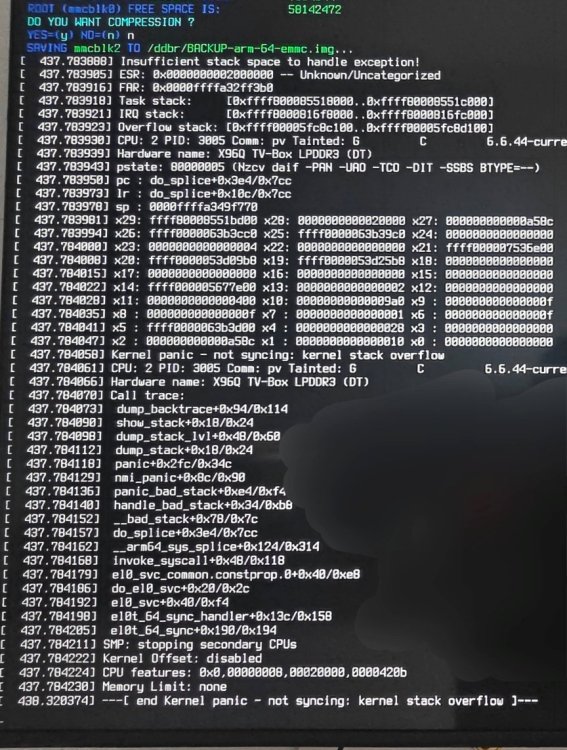All Activity
- Past hour
-
sorry to hear about your troubles The Tritium H5 is maintained by https://github.com/Tonymac32. Not sure if he is active here in the forum.
-
My experience is that the edge kernel is stable enough, but if you act like a disk-jockey (playing with disks or SD-cards/images nowadays) you destroy your success potentially every time you try some new image. Instead, pick a distro Debian or Ubuntu when Armbian, and make backups and/or do snapshots of what worked and then install packages variants. You can have vendor, current, edge kernels installed at the same time. A lot faster build maybe because the kernel is already build by some person or some computer before, so you get it fetched from a cache. I have added the beta repo in my sources so I can select between various kernels (and U-Boot variants). You need a bootmanager though, so own extlinux.conf script or wipe standard boot.* files and make sure EFI works, with GRUB or so. The latter works fine if you don't need overlays etc, so more use the SBC as PC then as embedded board to control things via GPIO pins or so. You can also re-install a specific kernel every time, but that does not work when the one you wanted to run does not start the board or crashes it. The OPi5plus I would consider as a PC, I do that for similar boards like ROCK5B and NanoPi-R6C at least. I select kernel via GRUB and have a permanent serial console cable connected, so it also works without HDMI connected. It is mainly the choice between vendor and mainline, that is the state of ARM64 nowadays. Some new boards like RPi5 cannot run mainline yet, so then there is little need to have a bootmanager, then you need the disk-jockey methods.
- Today
-
I've downloaded the latest stable Release of the source code: https://github.com/armbian/build/releases/tag/v25.8.1 When doing a Build, when it allows you to select the kernel branch: [vendor, mainline, edge], the only edge available for selection is the bleeding edge (i.e. latest trunk version). I've downloaded the 25.8.1 source code, and that's the edge version I want to compile. How do you build with the latest (relatively) stable edge kernel as is available in Armbian-Config? (i.e. currently v6.16.1-edge at Armbian 25.8.1)? Update #1 Building a full image (Trixie, Gnome, orangepi5-plus) with that edge kernel worked for me 24 hours ago, but now it isn't, even with the exact same options (except for some irrelevant kernel customizations yesterday when it worked). Apparently an ultra-recent change they in that kernel did broke something (the kernel was downloaded from the internet during compile). So I built a full image with the Vendor kernel. It was A LOT faster! And the output says it's from the 25.11.0 trunk, not 25.8.1. So it would appear the Released source code is an incorrect snapshot. I'll trying doing a git clone of branch v25.08 and see if that's actually 25.8, and see what happens... Result: 25.08 is actually version 25.08, not 25.8, even though the most recent file commit times in git correspond to 25.8, and also respectively for v25.05 with the times of 25.5.
-
Sorry, I don't have the Android dts, the Android image is erased. I have tried the image from niulinkcloud, The ethernet is working on this image, can we extract dts from this image?
-
look into understanding what armbian-config does behind the scenes and replicate that. I think that is a better option anyhow. armbian-config is known to royally screw up your system every now and then.
-
I flashed a fresh image to my uSD card via dd. $ sudo unxz -c Armbian_25.5.1_Tritium-h5_trixie_current_6.12.30_minimal.img.xz | dd of=/dev/sdf bs=1M oflag=direct conv=fsync status=progress iflag=fullblock When I loaded the uSD into my Tritium-H5 all I got was just the red power light, but no activity. Tried a few different power supplies with the same result. I finally figured out that it appeared the bootloader was missing. I used Libre Tech's flash tool to flash their bootloader to my uSD card. Now I was able to get the Tritium-H5 outputting the boot sequesnce on the serial console. However, it stops at: I stumbled through the u-Boot recovery process and after remounting the partition r/w I got dpkg to install linux-u-boot-tritium-h5-current_25.5.1_arm64__2024.01-S866c-P42f9-Hc721-V3ed7-Bb703-R448a.deb However, when I rebooted the Tritium-H5 I was still stuck on the above spoiler. 👆 Am I doing something wrong? How can I get the Tritium-H5 to boot the Armbian image? Thanks!
-

mxq pro 4k 5g allwinner h313 can't sd card boot
Ducdanh Nguyen replied to Ducdanh Nguyen's topic in Allwinner CPU Boxes
here is the ouput : @Nick A -

mxq pro 4k 5g allwinner h313 can't sd card boot
Ducdanh Nguyen replied to Ducdanh Nguyen's topic in Allwinner CPU Boxes
@Nick Aalright -

mxq pro 4k 5g allwinner h313 can't sd card boot
Nick A replied to Ducdanh Nguyen's topic in Allwinner CPU Boxes
Connect using 5037 -

mxq pro 4k 5g allwinner h313 can't sd card boot
Ducdanh Nguyen replied to Ducdanh Nguyen's topic in Allwinner CPU Boxes
Hello @Nick A, i'm on my linux virtual machine doing the following command, but i got some problem on it (i have installed every package needed): yes, i got the ip from the ifconfig command on termux 32bit if you are wondering glad you helped me -
@Nick AThe possibility of a cold solder joint is very low since both devices (with identical eMCP chips) exhibit the same symptoms. Additionally, SD card read/write functions normally within the Android system. Are there any alternative methods to install the OS onto the eMMC?
- Yesterday
-
Looking at the code, I don't see this being possible as built. Alternative option is scheduling a reboot sufficiently far enough out and hoping the operation has completed by that time.. thoughts?
-
I'm trying to run the following on edge devices, the remote interface to which does not support a traditional terminal (i.e. no interactivity): armbian-config --cmd ROO001 At the conclusion of this command running, the user is prompted through the UI/TUI to reboot the device. How can I avoid this reboot prompt, and just proceed with the reboot immediately? e.g. the Raspberry Pi OS raspi-config tool allows for the nonint parameter to be passed: raspi-config nonint enable_overlayfs The intent is to automate enabling of the read-only fs. Hardware is various Raspberry Pi and ROCK Pi devices running Armbian. I've already confirmed the command works fine with user input. I just need to understand how to interact with the tool without user input. Thank you
-
If I run a update after changing kernel to edge it doesn't matter the version, it breaks boot, idk why, but it is installing dtb for kernel 6.16 even with kernel 6.13 or 14 installed, current kernel does not support analog audio out of the box and I managed to get it working a few times, so I'm stuck with edge kernel, did a update then changed to edge kernel and disabled armbian updates until this bug is fixed
-
Hi. I am not complaining. I just would like to understand why I must deactivate https://ppa.launchpadcontent.net/liujianfeng1994/rockchip-multimedia/ubuntu/ if I want watching video on Youtube. If it's needed to disable this repo for watching video. I am ok. But why I can't read video with package from this repo? https://paste.armbian.com/vaxedisuda
-
What does: ffmpeg -codecs | grep hevc show? Even if it seems to support rkmpp, you can guess that it is broken. So install/get a dedicated external encoder. 2 people in this topic tread show working options. I can't help you any more, you need to do your homework so to say.
-

fighting with netplan/networkd/networkmanager
tabrisnet replied to tabrisnet's topic in Software, Applications, Userspace
@Igor how often does netplan run? how possible might it be to sneak in a sed -i -e 's/PermanentMACAddress/MACAddress/' /run/systemd/network/* networkctl reload in my bootup sequence? will DHCP [on ethEXT1] or carrier up/down events break this? -
Hello, Here is the ffmpeg version : gart@orangepi5:~$ ffmpeg ffmpeg version 6.1.1-3ubuntu5+git240504.09cd2a2~noble Copyright (c) 2000-2023 the FFmpeg developers built with gcc 13 (Ubuntu 13.2.0-23ubuntu4) configuration: --prefix=/usr --extra-version='3ubuntu5+git240504.09cd2a2~noble' --toolchain=hardened --libdir=/usr/lib/aarch64-linux-gnu --incdir=/usr/include/aarch64-linux-gnu --arch=arm64 --enable-gpl --disable-stripping --disable-omx --enable-gnutls --enable-libaom --enable-libass --enable-libbs2b --enable-libcaca --enable-libcdio --enable-libcodec2 --enable-libdav1d --enable-libflite --enable-libfontconfig --enable-libfreetype --enable-libfribidi --enable-libglslang --enable-libgme --enable-libgsm --enable-libharfbuzz --enable-libmp3lame --enable-libmysofa --enable-libopenjpeg --enable-libopenmpt --enable-libopus --enable-librubberband --enable-libshine --enable-libsnappy --enable-libsoxr --enable-libspeex --enable-libtheora --enable-libtwolame --enable-libvidstab --enable-libvorbis --enable-libvpx --enable-libwebp --enable-libx265 --enable-libxml2 --enable-libxvid --enable-libzimg --enable-openal --enable-opencl --enable-opengl --enable-version3 --enable-rkmpp --enable-rkrga --disable-sndio --enable-libdc1394 --enable-libdrm --enable-libiec61883 --enable-chromaprint --enable-frei0r --enable-ladspa --enable-libbluray --enable-libjack --enable-libpulse --enable-librabbitmq --enable-librist --enable-libsrt --enable-libssh --enable-libsvtav1 --enable-libx264 --enable-libzmq --enable-libzvbi --enable-lv2 --enable-sdl2 --enable-libplacebo --enable-librav1e --enable-pocketsphinx --enable-librsvg --enable-libjxl --enable-shared libavutil 58. 29.100 / 58. 29.100 libavcodec 60. 31.102 / 60. 31.102 libavformat 60. 16.100 / 60. 16.100 libavdevice 60. 3.100 / 60. 3.100 libavfilter 9. 12.100 / 9. 12.100 libswscale 7. 5.100 / 7. 5.100 libswresample 4. 12.100 / 4. 12.100 libpostproc 57. 3.100 / 57. 3.100 Hyper fast Audio and Video encoder I simply used the ffmpeg in the distro : art@orangepi5:~$ cat /etc/armbian-release # PLEASE DO NOT EDIT THIS FILE BOARD=orangepi5 BOARD_NAME="Orange Pi 5" BOARDFAMILY=rockchip-rk3588 BUILD_REPOSITORY_URL=https://github.com/armbian/build BUILD_REPOSITORY_COMMIT=195b3c7d0 LINUXFAMILY=rk35xx ARCH=arm64 BOOT_SOC=rk3588 IMAGE_TYPE=stable BOARD_TYPE=conf INITRD_ARCH=arm64 KERNEL_IMAGE_TYPE=Image KERNEL_TARGET=current,edge,vendor KERNEL_TEST_TARGET=vendor,current FORCE_BOOTSCRIPT_UPDATE= FORCE_UBOOT_UPDATE= OVERLAY_DIR="/boot/dtb/rockchip/overlay" VENDOR="Armbian" VENDORCOLOR="247;16;0" VENDORDOCS="https://docs.armbian.com" VENDORURL="https://www.armbian.com" VENDORSUPPORT="https://forum.armbian.com" VENDORBUGS="https://www.armbian.com/bugs" BOOTSCRIPT_FORCE_UPDATE="no" BOOTSCRIPT_DST="boot.cmd" VERSION=25.8.1 REVISION=25.8.1 BR,
-
@buzz89In oranges zero2 dts it has a 3.3v regulator defined as reg_dcdce. There’s only 5v defined in the vontar dts. You can add this to your dts reg_dcdce: dcdce { regulator-always-on; regulator-min-microvolt = <3300000>; regulator-max-microvolt = <3300000>; regulator-name = "vcc-eth-mmc"; }; https://linux.googlesource.com/linux/kernel/git/bpf/bpf/+/refs/tags/v6.9-rc2/arch/arm64/boot/dts/allwinner/sun50i-h616-orangepi-zero2.dts you can borrow code off these boards as well https://linux-sunxi.org/index.php?search=RTL8211F&title=Special%3ASearch&go=Go if you can extract your android dts for more clues.
-
@ARx8X98h has a similar AIC8800D wifi chip. You could probably use the wifi section from x98h dts. I have never had problems with my sdcard. Maybe it’s a bad solder joint?
-
unable to build. dts/upstream/src/arm64/allwinner/sun50i-h616-vontar-h618.dtb: ERROR (phandle_references): /soc/ethernet@5020000: Reference to non-existent node or label "reg_dcdce" @@ -23,7 +23,7 @@ diff --speed-large-files --no-dereference --minimal -Naur u-boot-2024.01-rc3/dts + mmc0 = &mmc0; + mmc1 = &mmc1; + mmc2 = &mmc2; -+ ethernet0 = &emac1; ++ ethernet0 = &emac0; + serial0 = &uart0; + }; + @@ -61,21 +61,21 @@ diff --speed-large-files --no-dereference --minimal -Naur u-boot-2024.01-rc3/dts + status = "okay"; +}; + -+&emac1 { ++&emac0 { + pinctrl-names = "default"; -+ pinctrl-0 = <&rmii_pins>; ++ pinctrl-0 = <&ext_rgmii_pins>; + phy-mode = "rmii"; -+ phy-handle = <&rmii_phy>; -+ phy-supply = <®_aldo1>; ++ phy-handle = <&ext_rgmii_pins>; ++ phy-supply = <®_dcdce>; + allwinner,rx-delay-ps = <3100>; + allwinner,tx-delay-ps = <700>; + status = "okay"; +}; + +&mdio1 { -+ rmii_phy: ethernet-phy@16 { ++ rmii_phy: ethernet-phy@0 { + compatible = "ethernet-phy-ieee802.3-c22"; -+ reg = <16>; ++ reg = <0>; + }; +}; +
-
@Nick AJust tried, couldn't start with SD. It's worse than before.😔.Currently, it can only run on the SD card using the x96Q-tvbox image. However, writing data to the SD card causes data loss or system crashes. I've already tried almost 10 different models of SD cards. Why is this happening? Have you encountered similar issues before?It usually freezes, and the box's light turns red. Occasionally, it crashes with the error shown in the screenshot.
-
RTL8211F Is an external gigabit chip. Maybe this post will help.
-
@justanothernoob the images with "current" instead of "vendor" in the name have very limited hardware support (no HDMI, no sound, etc). You should peek the "vendor" images. Mind I noted to use the images dated 16th of August or post as otherwise your pcie sata connected drives won't work most of the time. So you should try bookworm_vendor or noble_vendor with xfce,cinnamon,gnome,kde-neon if you want a graphical interface and minimal for serial console/ssh only. You will only get black screen from HDMI with "current" images, that is expected (the HDMI support is not in the linux kernel, only in linux-rockchip kernel, ie vendor as of yet). ie the image you told using https://fi.mirror.armbian.de/incoming/prahal/rock-5-itx/archive/Armbian_25.8.1_Rock-5-itx_bookworm_current_6.12.41_minimal.img.xz is such a linux kernel without HDMI support for rock-5-itx. https://fi.mirror.armbian.de/incoming/prahal/rock-5-itx/archive/Armbian_25.8.1_Rock-5-itx_bookworm_vendor_6.1.115_xfce_desktop.img.xz has HDMI support. you should be able to install form serial console with both vendor and current images. Mind I still need to read about installing RoobiOS on my emmc as sadly my board was shipped with an empty EMMC. So I cannot yet guide you through RoobiOS boot selection.



